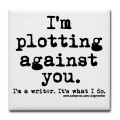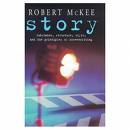Well, here goes… my first blog post as the new kid on the Wicked Writers' block.
[caption id="attachment_1992" align="alignright" width="124" caption="Potting? Who said Potting?"]
 [/caption]
[/caption]To plot or not to plot. My post will take a cursory look at the issue of whether a writer should have a good idea of their destination, and set out with a route map in hand or whether they should set out as an explorer, with merely the “idea” of the direction that their artistic travels might take.
Do you pooh-pooh the notion of sitting down and planning, in detail, how your story will unfold, preferring to bow to the elevated status of literary prose? Or do you scratch your head (carefully avoiding splinters) and trace out the necessary plot turns and twists and the character traits to be observed on the journey?
[caption id="attachment_1993" align="alignleft" width="120" caption="That's better - I said Plotting"]
 [/caption]
[/caption]If you’re a reader, do you enjoy a ramble through the machinations of your favourite author’s literary musings? Or do you pick up the books of that author knowing that the journey they take you on will, in labyrinthine style, guide you through thrills and spills, holding your hand, knowing, with confidence, that the author will reveal to you a new and exciting destination?
James Scott Bell writes in his book Plot and Structure that “Some writers, critics, and other assorted literati sniff at plotting as a tool of craft. …[it is] something decent people don’t do.”
Certainly, we can assume that an extended synopsis of a proposed novel – as a detailed writer’s “road map” – restricts the scope for characters and events to evolve in exciting and surprising directions. Such restrictions reduce the scope to offer readers new insights into the characters’/writer’s world. And given such restrictions, perhaps those other writers, critics and assorted literati have a point. If a writer plots to the nth degree, then scope for the artist’s “art” is severely limited and writing becomes recipe-driven. How many times have we seen a new writer’s break-through success followed by formulaic mediocrity?
[caption id="attachment_1997" align="alignright" width="87" caption="James Scott Bell"]
 [/caption]
[/caption]If, however, a writer disregards the elements of plot that can be traced back to the Greek philosophers of old, they also disregard the nature of the audience experience and risk loosing their readers’ engagement through a succession of wanderings into literary superlatives. How many times have we picked up a book on the recommendation that it has been the receiver of some major literary award, only to find the prose leaves you distinctly disengaged with any conception of an underlying story, wondering where on earth the book is taking you and… should you put the coffee on and go do something else, something more entertaining?
As Robert McKee in his work Story says, “As important as language is, however, it’s only the surface by which we capture the reader to lead him to the inner life of the story. Language is a tool for self-expression and must never become a decorative end of its own.”
[caption id="attachment_1998" align="alignleft" width="130" caption="Robert McKee"]
 [/caption]
[/caption]My own view is that there is a time and a place for plotting and non-plotting.
I believe it is necessary that the author, as an artist, should understand two necessary but conflicting responsibilities in realizing their written work. First, there is the responsibility to apply their word craft as an artform. Call this the desire to pen our word pictures with as much concentration on the creativity with which we can manipulate language – even to the point of reaching the “decorative end”. Secondly, there is the responsibility to retain a connection with the expectations of the audience.
So, with my apologies to the great Bard himself, to plot or not to plot – that is the question: whether 'tis nobler in the mind to suffer the slings and arrows of outrageous fortune and bow to the mass market desire for good quality commercial fiction, or to take arms against a sea of expectation… And, by opposing, challenge the norm and deliver the true art in words?
[caption id="attachment_2002" align="alignright" width="114" caption="To plot or not to plot..."]
 [/caption]
[/caption]For the new author, learning the craft of writing, I would advocate that it is easier to bend to expectations. There is time enough to challenge the norm when you have gained the strength of having mastered your craft. It also depends on whether or not you might be writing in order to earn a living from the sale of your books.
And, before the obvious question, having quoted from two books on the subject of story and plot structure, can I recommend these works?
In the words of a dear and departed relative, inscribing a note in a book he presented to me before I joined my first ship, in a naval career started so many moons ago I prefer to forget – “A good book will not teach you anything, but you can learn a lot from it!”

Great first post, David!! I can be an extreme planner, but sometimes I've just got to let the story write itself as it comes to me. If I don't, it will nag at me like a five-year-old at a toy store until I give in. I guess I'm just a weak writer, giving in to the whims of the universe.
ReplyDeleteDavid - what a fabulous first post!
ReplyDeleteI don't plan anything until the rewrite. I just go with the flow through the first draft an see what comes up. I guess some could say that IS my outline. The most prep I do is a small character sketch and a paragraph about the plot as I first imagined it. Of course during the rewrite I get a little more organized.
I use this great program yWriter5 and it allows you split up scenes. And witha click of a button it spits out an outline based on what you've typed up! So I have an easy way to see things and can jot notes down if things need rearranging. Plus it makes it a lot easier to edit one scene at a time instead of thinking a whole chapter at a time. (Especially when my chapters average 5,000 words each!)
Again, great job David! I'm going to see about getting those books now!
Glad you liked the post, Wendy. I've been struggling with IT problems today, so a little late in seeing your comment. I think extreme planning is great, providing you have sufficient gaps in the plans, and it sounds like you do that. My own "extreme" planning includes spread sheets to track sections (with one-liner descriptions, word counts and POV shifts). But, once it comes to writing, I sit and pour out around 5000 words a day without refering back to the plan at all.
ReplyDeleteHi, Harley. Thank you. I'm glad you liked the post. A character sketch and a paragraph would certainly constitute a measure of planning, and I can certainly see the value in using software. I use spread sheets to keep tack of, and manage, sections/scenes. I also use a spread sheet to map out the years in the principle characters' lives - like births, key events etc. It is amazing how helpful it can be to aid consistency and coherence in the plot line. You could say that my software spits out the outline and I fill in the gaps! I would certainly agree with working scene by scene. I didn't think chapters until all my scenes were at their first draft. In fact, it is Robert McKee's book I am reading at the moment. The book has a screenwriter focus and talks in terms of scenes, but I think it is excellent reading for novel writing. Bottom line though, although I think some plotting is necessary, it should never become an end itself. All plans change during impletmentation and plots are another form of plan! Have a great weekend, Harley.
ReplyDeleteWelcome to Wicked Writers, David. Great first post, even better than my own inaugural blog.
ReplyDeleteBut, seriously, I hope you continue to draw the numbers you did today. Then, Wendy, Supriya and CJ will forget my pulling everyone else down.
Thank you for the welcome and the kind words, Greg. I'm looking forward to more posts and hopefully kicking off more interest.
ReplyDeleteI'm a plotter, but I'm also in awe of people who can write without any plan and have the story make sense in the end. I think it take a lot of conifidence (and trust in the muse) to do that. I don't have much faith in muses.
ReplyDeleteI like to plot from the villain's point of view, then write the story from inside my protagonist's head. I think it helps with the sagging middle because I can more easily keep in mind what my villain is doing to thwart my protag's efforts.
Hi, Heidi. Thanks for stopping by to comment.
ReplyDeleteI have heard that those who write without plotting tend to rewrite the whole MS after putting the first draft aside. You could almost call that first draft a "plot", in such cases.
In another "black-art", when I developed software for a living, there were those of us who designed a program - we didn't start writing code until much later in the process. Then there were those that just wrote programs straight from their heads, through their hands, onto a keyboard and screen. Those "artists" would spend a lot of time rewriting code as they went about testing their programs. Whereas we "designers" would achieve the end objective within the same time frame, but with less need for rewriting.
It is the richness in the variety of ways we all adopt in achieving similar goals that provides us with such individualism. Long may plotters and non-plotters continue!
[...] David Sartof, Sring Time and Thoughts Turn to Plotting [...]
ReplyDelete